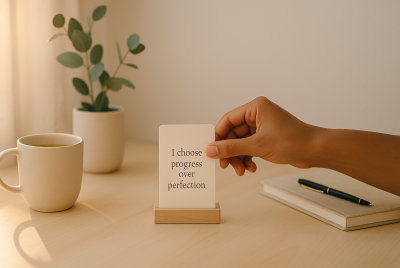Goal Setting for Adolescents: A Guide to Building Healthy Habits
We may earn a commission for purchases made using our links. Please see our disclosure to learn more.
Setting goals isn’t just for adults or high-performing professionals—it’s one of the most powerful tools teens can use to shape their future. Goal setting for adolescent builds essential life skills like discipline, time management, and resilience. And the best part? These skills stick with them into adulthood.
Let’s explore why it’s crucial to help teens set the right goals, how to support them through the process, and what tools can make the journey smoother.
Why Goal Setting Matters for Adolescent
Adolescence is a time of rapid growth and self-discovery. Teens are figuring out who they are, what they care about, and how they fit into the world. Having structured goals gives them:
- A sense of direction in the midst of confusion
- Boosted self-esteem from achieving milestones
- A productive outlet for their energy and ambition
- Resilience when facing academic or social challenges
Research from the American Psychological Association shows that teens who set personal goals report higher motivation and lower levels of anxiety.

Understanding the Adolescent Mindset
Teen brains are still developing—especially the prefrontal cortex, which is responsible for planning and decision-making. That’s why impulsive choices are common and why goal setting must be simple, structured, and supportive.
They may resist routines or long-term planning unless they clearly see the “why.” Connecting goals to their passions—like sports, gaming, music, or friendships—makes it more likely they’ll stick with them.
Types of Goals Adolescent Should Set
Academic Goals
These might include raising a grade, finishing homework on time, or studying more consistently.
Example: “I will complete all my math assignments this month before the due date.”
Personal Development Goals
Teens can work on their emotional intelligence, communication skills, or hobbies.
Example: “I will read one personal development book this semester.”
Health and Wellness Goals
This covers physical activity, nutrition, and sleep habits.
Example: “I will go for a 20-minute walk five times a week.”
Social and Emotional Goals
Improving friendships, handling conflict better, or joining new clubs can be impactful.
Example: “I will start one meaningful conversation with a new classmate each week.”
How to Teach Goal Setting to Adolescent
Start with a Vision
Ask: “What’s something you really want to achieve this year?” Starting with big-picture thinking helps clarify what matters most to them.
Use the SMART Goal Framework
Specific. Measurable. Achievable. Relevant. Time-bound.
This makes abstract dreams more concrete. Instead of saying, “I want better grades,” say “I will improve my science grade from a B to an A by the next report card.”
Break Goals Into Manageable Steps
One big goal can feel overwhelming. Break it into bite-sized steps so progress feels doable. Use planners, habit trackers, or even a simple sticky note system.
Common Mistakes Teens Make with Goals—and How to Avoid Them
- Setting goals that are too vague or ambitious
- Trying to change everything at once
- Not tracking progress or celebrating wins
The fix? Encourage one small, specific goal at a time. Check in regularly. And don’t forget to celebrate—even small wins matter.
Recommended Tools to Help Teens Set and Track Goals
Goal Journal for Teens
This printed journal encourages monthly reflection and growth, ideal for building discipline.
➡️ View product
Vision Board Kit for Teen Girls
Packed with stickers, affirmations, and inspiring visuals to help teens map out their dreams.
➡️ View product
Gratitude & Habit Tracker Journal
Helps teens reflect, build routines, and develop positive habits for long-term change.
➡️ View product
Big Life Journal: Teen Edition
This journal is designed to help teens develop a growth mindset through guided prompts and activities. It encourages self-reflection and goal setting in a structured format.
➡️ View product
MakseLife Goal Setting Planner
This planner combines goal setting with weekly and monthly planning pages, helping teens break down their objectives into actionable steps. Its user-friendly design makes it suitable for daily use.
➡️ View product
For those interested in developing stronger focus and routine habits, check out this helpful guide on practical tools for mastering time management, perfect for teens learning to balance school, hobbies, and personal growth.
Encouraging Accountability and Motivation
Even with the best tools, teens need external motivation—especially early on. Try these strategies:
- Set regular check-ins (weekly or biweekly)
- Use positive reinforcement rather than punishment
- Be a role model—share your own goals and progress
- Build in rewards when they hit milestones
If you’re a teacher or parent, gentle nudges, encouragement, and honest conversations can go a long way.

Scientific Insights: How Research Supports Goal Setting in Adolescent
Scientific research continues to highlight the powerful impact of structured goal setting during adolescence—not just on performance, but on mental well-being and long-term development.
Building Trust and Confidence Through Therapeutic Goal Setting
A study published by BMC Psychology reveals that goal setting helps build therapeutic relationships in adolescents by making personal challenges feel more manageable and achievable. This process fosters open communication between young individuals and their caregivers or mentors, allowing teens to take active ownership of their growth.
➡️ Read how goal setting supports adolescent mental health
What 16 Years of Research Tells Us
A comprehensive literature review analyzing adolescent goal content and pursuit across 94 studies confirms that teens benefit most when their goals are aligned with intrinsic motivation and supported by their environment. The review covers how personal values, school dynamics, and social relationships shape goal commitment and follow-through.
➡️ Explore the long-term findings on adolescent goal pursuit
These findings emphasize that structured, meaningful goals are not just helpful—they are essential tools for supporting teens’ emotional resilience, future orientation, and academic success.
Final Thoughts: Empowering Teens Through Purposeful Goals
When teens set goals they care about—and see themselves making progress—they begin to believe in their own potential. Goal setting for adolescent isn’t about pressuring them to succeed; it’s about giving them the tools to take charge of their journey.
Want to support a teen in your life? Start by asking: “What would you like to be proud of this year?” Then help them chart a path to get there.
FAQs About Adolescent Goal Setting
1. At what age should adolescents start setting goals?
Most kids can start practicing simple goal setting around age 10–12, but middle and high schoolers benefit most from structured goal-setting programs.
2. What are some examples of realistic goals for teens?
Examples include completing daily homework, reducing screen time, joining a club, or working out 3 times a week.
3. How can I motivate a teenager who doesn’t care about goals?
Link goals to their interests or passions. Start small and make the rewards tangible. Help them visualize the outcome.
4. Should goals be written down?
Absolutely. Writing makes goals feel real and increases commitment. Visual goal charts or journals work great.
5. What if a teen fails to reach their goal?
That’s okay. Focus on what they learned and encourage them to adjust the goal. Failures are a natural part of the process.




